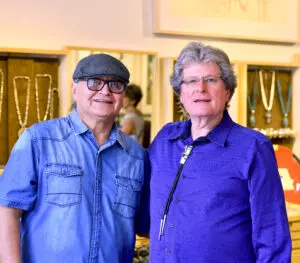
Ric Charlie is the most innovative jeweler of our time, utilizing the ancient technique of Tufa Casting. Ric creates multi-level dimensional jewelry by meticulously cutting the designs with flawless precision. Each design is hand cast, formed, filed, sanded, and polished to perfection. Finally, diamonds and semi-precious gemstones are set to accent each piece for sale to the discriminating collector.
Ric Charlie is noted for his fine tufa cast work. His jewelry often has added colorful patinas in shades of gold, rust, red, purple, blue, and green, achieved by adding liver of sulfur to the silver. His pieces use Navajo landscape scenes, Yei Bi’Ci’s spiritual figures, and sand painting designs. The fine lines in his jewelry are accomplished by incising the tufa stone with the dental tools Ric has used for over 20 years. He uses a wide range of techniques, including mosaic, channel inlay, and set natural stones. Ric is also a painter and sculptor.
Born in Tuba City, Arizona in 1959, Ric is of Tsi’naa’jinii’ (Black-Streaked-Wood-People) and Ta’baahi’ (Edgewater) Clans. Growing up under humble circumstances with his grandparents in the sun streaked red cliffs, Ric learned the traditional ways while watching the old ones slowly adjust to new technology and world ideas. He began experimenting with jewelry making and learned the basic techniques while in high school. He attended Arizona State University in Tempe and the University of Arizona in Tucson with sports scholarships. There, he formally studied jewelry making and design.
However, in the area of tufa casting, Ric is largely a self-taught artist. The technique he uses was not part ofdio art curriculum. He apprenticed to other jewelers whose work he admired and set himself a goal of making his college stu the lines fine and clean.
Ric has been a practicing jeweler since the early 1970s. Today, in addition to pursuing and perfecting his own career, Ric teaches and advises young Native artists from around the world on his distinctive tufa stone casting methods.
During his lifetime, Ric has had a strong sense of being a part of Monument Valley and has felt like it was him home. So a lot of his work has the Monument Valley scenery. “Every time I feel down, I always think about my place in life, and I feel that I have something to give into this world…”



